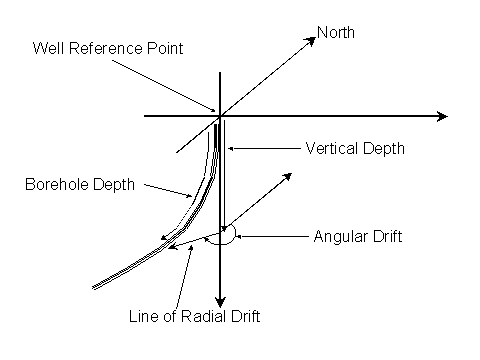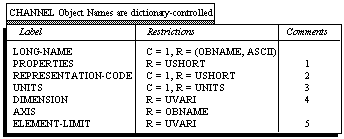
Figure 4-1. Illustration of Spatial Coordinate System of a Well
The Name of an Object is the value of the Name Characteristic (all Subfields) of its Object Component.
When exceptions are made it is because the set of Value Elements can be subdivided into equal-size subgroups, each of which has some higher semantic meaning (defined externally to the Attribute) than the individual Elements. For example, if a given Attribute has a Value with three Elements, then it is possible for a different Attribute to contain five instances of the first Attribute’s Value, linearly ordered. The latter Attribute would have a Value with fifteen Elements. Both Attributes, of course, would have to have the same Representation Code and Units Characteristics.
Spatial coordinates of a well are depth, Radial Drift, and Angular Drift. Depth is defined in terms of Borehole Depth or Vertical Depth. Figure 4-1 illustrates the spatial coordinate system of a well.

Figure 4-1. Illustration of Spatial Coordinate System of a Well
Comments:
Appendix A specifies the assignment of numeric codes for Public and Private Logical Records and the assignment of Set Types to Public EFLRs.
There is a dictionary of integer Company Codes administered by POSC (see Appendix G). The name of any Private Data Set Type shall have the form code-TYPE, where code is the ASCII representation of the Company Code of the Producer that defines the Type, and TYPE is an arbitrary name administered by the Producer.
If Producer A has Company code 123, for example, then all Private Data Set Types for Producer A are identified as 123-TYPE. Specific examples might be 123-PICTURE, 123-GRID, etc.
In order to preserve the FILE-HEADER Object as a "fixed-length" record (see §5.1), the Origin Subfield value in the Name of the Defining Origin must be less than 12810.
Some names are dictionary-controlled It is not within the scope of this specification to define the administration of the dictionaries or the mechanisms for implementing them beyond the semantics specified in Chapter 7.
When an Object of a given Type is defined in this specification, it shall be stated whether the Names are controlled by a dictionary. Such Object Names carry semantic meaning. Object Names that are not dictionary-controlled shall have no semantic meaning. Such Names are used only to distinguish one Object from another of the same Type.
In general the sequential ordering between an Object and the Object that references it is arbitrary, when both are present in the same Logical File, except that no IFLR may appear between them. This rule also holds for Objects that have Attributes referenced from other Objects.
Exceptions for Public Data are limited to the following:
• An UPDATE Object must follow any Object that it references. IFLRs may appear between an UPDATE Object and other Objects that it references.
• IFLRs may appear between an Object in a Replacement Set and other Objects that it references or that reference it.
The restrictions must be stated explicitly in the definition. If the restriction is not stated, then no assumptions about the Characteristics of a given Attribute may be made by a Consumer. In this document, the following format is used to define Attributes of an Object:

Figure 4-2. Sample Format for Defining Attributes of an Object
In Figure 4-2, C denotes the Count Characteristic and R denotes the Representation Code Characteristic. The Label Characteristic is defined explicitly in the left column. It is also permissible to restrict the Units Characteristic and the Value Characteristic, although these restrictions are not illustrated in the above table.
A restriction, if it exists, is stated as an enumeration of one or more allowed values.
Even if an Attribute’s Characteristics are explicitly restricted in this standard, it is still necessary to record the Characteristics according to the rules of the Template and Global default values described in Chapter 3.
Certain Attributes are used by many different Object Types. Four such Attributes, Long-Name, Description, Dimension and Axis, are described here. Redundant comments may be omitted when these Attributes appear in the definitions of Objects in later chapters.

Figure 4-3. Definition of the Long-Name Attribute
Comment:

Figure 4-4. Definition of the Description Attribute
Comment:
Figure 4-5 defines the Dimension Attribute.

Figure 4-5. Definition of the Dimension Attribute
Comment:
The Count of the Dimension Attribute specifies the number of dimensions of the array, i.e., its dimensionality. Each Value Element of the Dimension Attribute specifies the size of an array dimension. For example, with Count = 3 and Value = {3, 4, 128}, a 3 x 4 x 128 array is defined. The total number of elements of the defined array is the product of the Value Elements of the Dimension Attribute. In the example, the defined array has 1,536 elements.
The mapping of the linear sequence of array elements to the array structure defined by the Dimension Attribute is such that the first dimension index changes most rapidly, and the last dimension index changes most slowly. If the elements of the array are denoted by A i,j,k, then the linear order of array elements is
A1,1,1, A2,1,1, A3,1,1, A1,2,1, A2,2,1, ..., A3,4,1, A1,1,2, A2,1,2, ..., A3,4,128
When the Count Characteristic is zero, there are no dimensions defined for the array, and the array is undefined, i.e., the array is considered to be Absent.
The total size in bytes of an array is the sum of its individual element sizes. For certain Representation Codes the size of each element is constant, and the total size is the number of elements multiplied by this size. With other Representation Codes, UVARI and ASCII for example, the size of each element is potentially different, and the total sample size must be determined by adding the sizes of all the elements.

Figure 4-6. Definition of the Axis Attribute
Comment:
The Axis Objects referenced by the Axis Attribute further specify the semantic features of the individual coordinate axes associated with the array. The order in which the Axis Objects are referenced in this Attribute corresponds with the order in which the array dimensions are specified in the Dimension Attribute. That is, the first referenced Axis Object describes the semantics of the first (fastest varying) dimension, and so on.